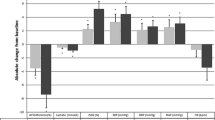Abstract
The purpose of this study is to assess the effect of calcium bolus in response to a hypotensive episode by assessing high-fidelity hemodynamic data obtained from children with single-ventricle physiology with parallel circulation. Single-center, retrospective analysis of hemodynamic data after calcium bolus administrations within the first 2 weeks post-surgery. Time intervals were the baseline (− 60 to − 10 min); the hypotensive episode (− 10 to 0 min); time point zero at the bolus administration; and the response (0 to 60 min). The main responses assessed were the peak increase in mean blood pressure (mBP), duration of the response after the bolus, and markers of oximetric effects. These analyses included 128 boluses in 63 patients. Of the total boluses analyzed, 80% increased the mBP by 5 mmHg or higher with the effect lasting at least 10 min, whereas 10% of the boluses analyzed increased the mBP by 20 mmHg or higher with the effect lasting at least 50 min. The boluses induced a significant increase in arterial oxygen saturation and an upward trend in pulmonary-to-systemic flow ratio, without increasing renal or cerebral oxygen extraction ratios. Calcium chloride boluses are an effective rescue medication for hypotensive episodes in children with parallel circulation. They lead to an improvement in mBP, as well as an increase in pulmonary-to-systemic blood flow ratio. More importantly, these boluses do not compromise systemic oxygen delivery.

Similar content being viewed by others
Data Availability
The authors declare that the data supporting the findings of this study are available from the corresponding author, SF, upon reasonable request.
References
Michalak M, Opas M (2009) Endoplasmic and sarcoplasmic reticulum in the heart. Trends Cell Biol 19(6):253–259
Hong T, Shaw RM (2017) Cardiac T-tubule microanatomy and function. Physiol Rev 97(1):227–252
Lomivorotov VV, Leonova EA, Belletti A, Shmyrev VA, Landoni G (2020) Calcium administration during weaning from cardiopulmonary bypass: a narrative literature review. J Cardiothorac Vasc Anesth 34(1):235–244
Morrell DF, Jaros GG, Thornington R (1984) Calcium supplementation during cardiopulmonary bypass in paediatric surgery. S Afr Med J 66(10):367–368
Atsumi N, Abe M, Sakakibara Y, Terada Y, Jikuya T, Tsutsui T et al (1994) Influence of ionized calcium concentration during cardiopulmonary bypass on pediatric cardiac surgery. Kyobu Geka 47(7):544–548
Averin K, Villa C, Krawczeski CD, Pratt J, King E, Jefferies JL et al (2016) Initial observations of the effects of calcium chloride infusions in pediatric patients with low cardiac output. Pediatr Cardiol 37(3):610–617
Shapira N, Schaff HV, White RD, Pluth JR (1984) Hemodynamic effects of calcium chloride injection following cardiopulmonary bypass: response to bolus injection and continuous infusion. Ann Thorac Surg 37(2):133–140
Douglas WW, Rubin RP (1961) The role of calcium in the secretory response of the adrenal medulla to acetylcholine. J Physiol 159:40–57
Burn JH, Gibbons WR (1965) The release of noradrenaline from sympathetic fibres in relation to calcium concentration. J Physiol 181(1):214–223
Kimura S, Iwasaki T, Oe K, Shimizu K, Suemori T, Kanazawa T et al (2018) High ionized calcium concentration is associated with prolonged length of stay in the intensive care unit for postoperative pediatric cardiac patients. J Cardiothorac Vasc Anesth 32(4):1667–1675
Dyke PC 2nd, Yates AR, Cua CL, Hoffman TM, Hayes J, Feltes TF et al (2007) Increased calcium supplementation is associated with morbidity and mortality in the infant postoperative cardiac patient. Pediatr Crit Care Med 8(3):254–257
Dhillon S, Yu X, Zhang G, Cai S, Li J (2015) Clinical hemodynamic parameters do not accurately reflect systemic oxygen transport in neonates after the norwood procedure. Congenit Heart Dis 10(3):234–239
Tweddell JS, Hoffman GM, Fedderly RT, Berger S, Thomas JP Jr, Ghanayem NS et al (1999) Phenoxybenzamine improves systemic oxygen delivery after the Norwood procedure. Ann Thorac Surg 67(1):161–167
Tweddell JS, Hoffman GM, Fedderly RT, Ghanayem NS, Kampine JM, Berger S et al (2000) Patients at risk for low systemic oxygen delivery after the Norwood procedure. Ann Thorac Surg 69(6):1893–1899
Naito Y, Aoki M, Watanabe M, Ishibashi N, Agematsu K, Sughimoto K et al (2010) Factors affecting systemic oxygen delivery after Norwood procedure with Sano modification. Ann Thorac Surg 89(1):168–173
Li J, Zhang G, McCrindle BW, Holtby H, Humpl T, Cai S et al (2007) Profiles of hemodynamics and oxygen transport derived by using continuous measured oxygen consumption after the Norwood procedure. J Thorac Cardiovasc Surg 133(2):441–448
Funding
The authors did not receive support from any organization for the submitted work.
Author information
Authors and Affiliations
Corresponding author
Ethics declarations
Conflict of interest
The authors have no relevant financial or non-financial interests to disclose.
Ethical approval
This study was performed in line with the principles of the Declaration of Helsinki. Approval was granted by the Institutional Review Board of Baylor College of Medicine (H-40811).
Additional information
Publisher's Note
Springer Nature remains neutral with regard to jurisdictional claims in published maps and institutional affiliations.
Rights and permissions
About this article
Cite this article
Savorgnan, F., Flores, S., Loomba, R.S. et al. Hemodynamic Response to Calcium Chloride Boluses in Single-Ventricle Patients with Parallel Circulation. Pediatr Cardiol 43, 554–560 (2022). https://doi.org/10.1007/s00246-021-02754-3
Received:
Accepted:
Published:
Issue Date:
DOI: https://doi.org/10.1007/s00246-021-02754-3




